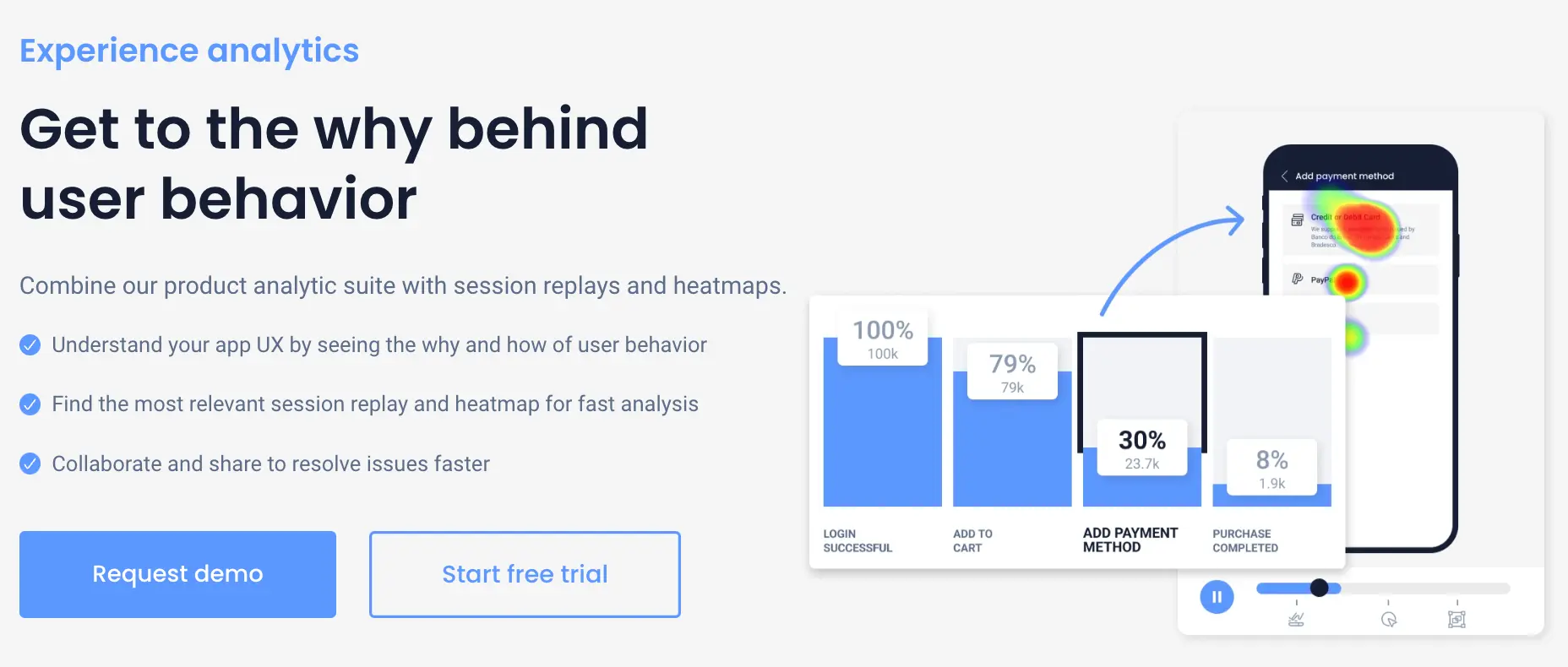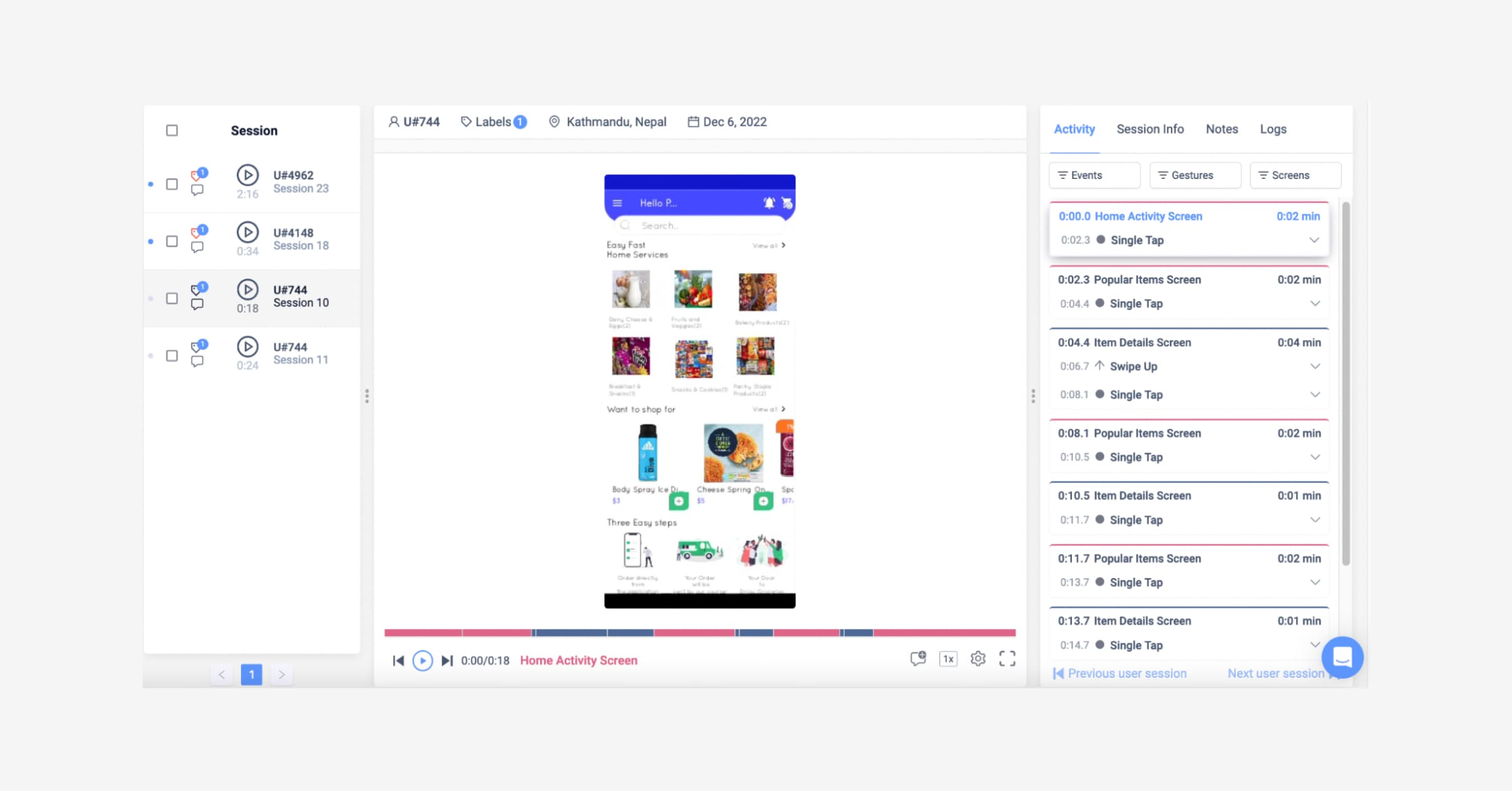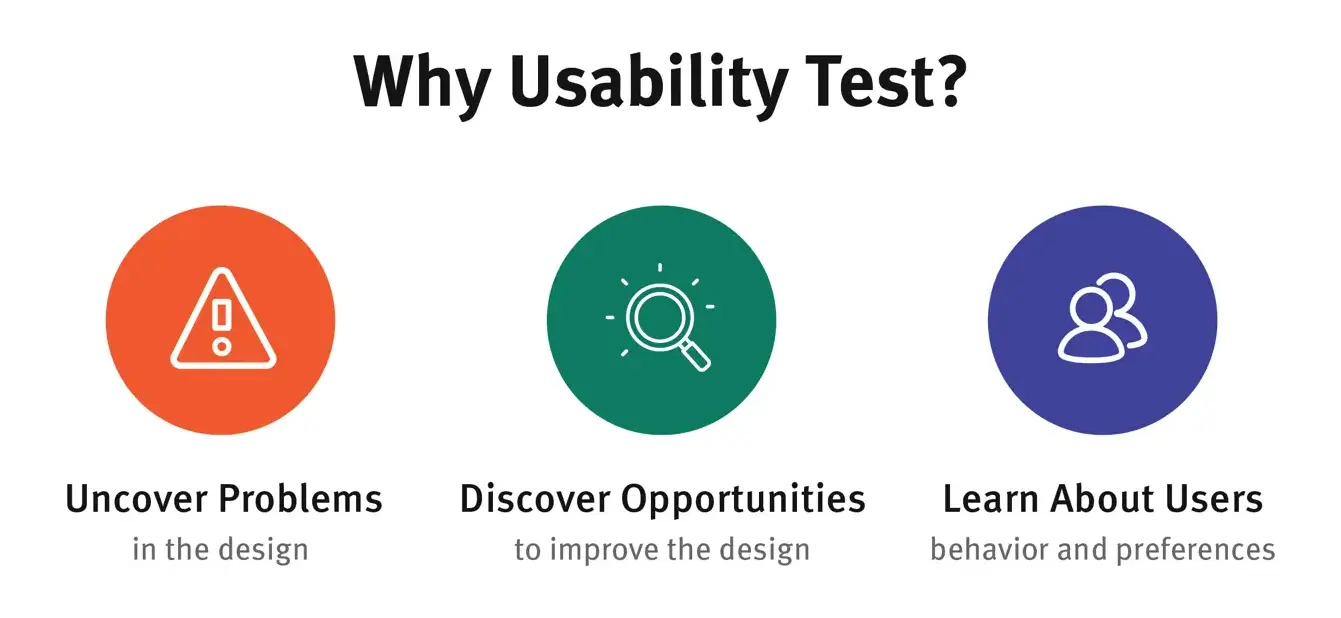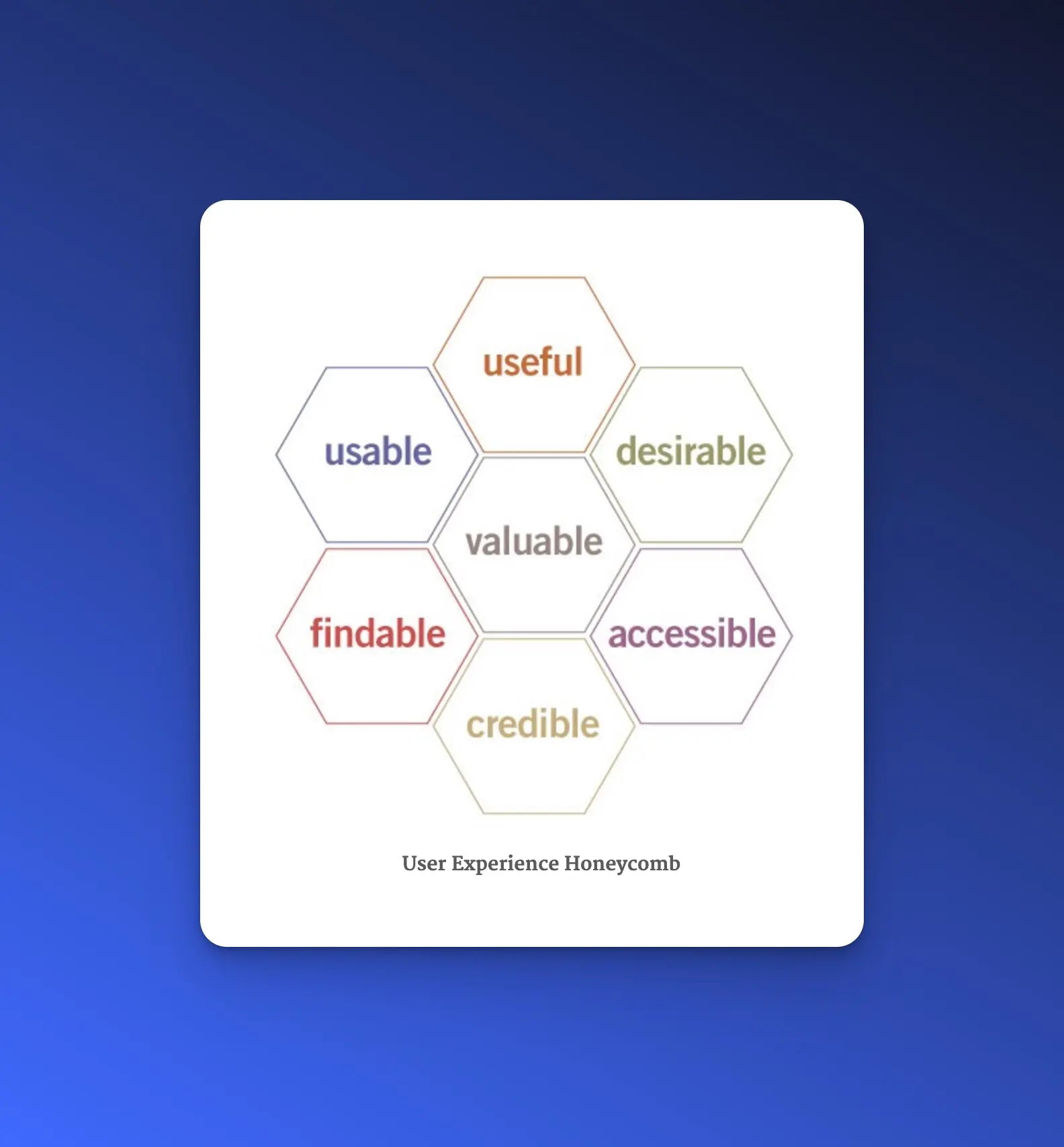Back to blog
7 MIN READ
UX Testing - Methods & Tools to Test User Experience
PUBLISHED
2 March, 2025

Product Analytics Expert
The true value of UX research is an evolving understanding of who your customers are and how they feel about using your app. UX testing hones in on your customer’s experience on a deeper level. You can find out whether your customers achieve their goals struggle-free. And whether your app design is intuitive enough so first-time users can always complete their tasks without assistance.
A key element of UX testing is observation. To understand natural behavior, product teams need to see genuine interactions. And that’s why the UXCam platform quietly collects session data as your users interact with your product. We achieve this with a mobile-only lightweight SDK, so our insights are as close to real behavior as possible.
Read on as we examine UX testing and what to consider when setting up your usability test process.
Summary - How to test user experience (UX) effectively
| How to test user experience | Description |
|---|---|
| Conduct usability testing | Ask real users to complete tasks and observe their behavior. |
| Use heatmaps & session recordings | Track where users click and how they navigate. |
| Run surveys & feedback forms | Collect direct insights from users about their experience. |
| Analyze user flows | Identify where users drop off or struggle in the journey. |
| A/B testing | Compare different designs to see which one performs better. |
What is UX testing?
UX testing is the process of evaluating a product's user experience by gathering feedback from target users. It involves using various methods, such as usability testing, user interviews, and surveys, to uncover insights and improve overall user satisfaction and engagement.
UX Testing, also known as Usability Testing, is a powerful research method and a critical step in design and product development. Its primary purpose is to evaluate whether your design is usable and intuitive to support people in achieving their goals by observing and reviewing how users interact with it.
UX Testing is usually conducted several times throughout product development. For example, when adding new features to an existing product.
UXCam tells you a lot about how people interact with your app. Our functionality is ideal for supporting remote moderated and unmoderated testing. We even offer session recordings that allow your teams to experience your user’s journey from their perspective, from the exact moment that a user opens your app, meaning you can analyze every second of a user’s journey.

You also get access to heatmaps that will show you the page elements that get used the most, alongside identifying specific frustration signals like rage taps. UXCam is a popular behavior analytics tool designed for mobile apps that helps teams to make confident design decisions based on natural behavior.

Different types of UX test methods
Nearly all testing and product research categories fall into three main categories of usability testing. One method may be more suitable depending on the app under test and your research goals.
Qualitative or quantitative
The main difference between qualitative and quantitative is the type of data collected and how. For a comprehensive evaluation of UX, product teams will need to make use of both.
Quantitative UX testing is focused on the “what” and indirectly collects and analyzes numerical data through a UX analytics tool like UXCam. It’s concerned with highlighting patterns and making design decisions based on the findings of metrics. For mobile app UX testing, these metrics may include churn and exit rate and customer lifetime value (CLV).
On the other hand, qualitative UX testing focuses on the “why” and assists teams in understanding why users interact the way they do with your app. The data is collected directly through session replays, heatmaps, and user journey analysis for signs of frustration, confusion, satisfaction, and other observational findings.
Moderated or unmoderated
Both methods have their advantages. However, a facilitator being there or not can make a difference in the research results.
Moderated testing is when a moderator is present during testing to observe, make notes, ask, or answer follow-up questions. Test moderators facilitate the session and can do so virtually using screen-sharing tech but are usually in the same room as the participants.
Unmoderated testing is when test participants test the product unsupervised. Participants are given instructions on how to complete the tests before the session. Usability testing tools or mobile analytic tools make testing possible with more significant numbers of participants. They record natural actions during sessions and gather data required for detailed analysis.
In-person or remote
In-person testing is when the physical location is essential for the test. It differs from moderated testing and is used when a significant amount of control is needed, or lots of physical props or test equipment is involved. In-person usability testing can take place in a usability lab or another facility.
Remote testing can be moderated or unmoderated. It just means that the usability tests occur when the participant and researcher are in different locations. A remote approach is helpful if you have a physical prototype to test; these can be sent to the participant and moderated using video conferencing tools. This type is typically performed using online test tools, sometimes a webcam recording if the session needs to be recorded.
UXCam makes this process a lot easier when testing mobile apps. Our session replays can record the in-app interactions of the entire test, then produce an analysis of the results for actionable insight.


Why is UX testing important?

In addition to understanding your users for better user-centered design, these are the main benefits of usability testing:
To identify problems like navigation, complex user flows, or findability issues in your design and to prevent those mistakes from getting into the live environment.
To identify improvement opportunities by understanding how people use your app.
To learn your target audience’s preferences based on accurate data.
How to do UX Testing
Step 1: Decide on your test objectives, test design, and scope
First, be clear about what you want your usability tests to discover. Defining your objectives is key, as it will shape almost all aspects of your testing.
Consider Peter Morville’s honeycomb of UX facets when thinking about test objectives and test design (test goals).

An example of a test objective may be to evaluate your apps’ findability based on first-time users completing a specified goal, like locating information or upgrading their subscription.
Ultimately, the test design will depend on the product or service type and where your app is in the development lifecycle. For example, usability tests like card sorting or concept testing will be more suitable for apps in the early design stages, like the prototype phase.
On the other hand, a fully developed app could be evaluated through session recordings and heat mapping. The data from usability and mobile analytic tools like user journeys will highlight how users navigate through your app to achieve their goals and whether they’re met with any hindrances.
Then there’s the scope.
The scope defines what will be tested; for example, you might want to test how easily your app is navigated. If you want your tests to determine how well your product performs compared to your competitors, consider including competitive usability testing. Your comparison can be comprehensive, using an overall app usability metrics evaluation, or you can focus on comparing specific features and design elements.
Step 2: Determine the test method
Now decide which is the most effective way to conduct your tests:
Quantitative or qualitative – If quantitative, which metrics will you measure, and how will you collect the data?
Moderated or unmoderated – If moderated, where will testing take place? What type of moderating technique will you use? How many sessions will you hold, and for how long?
Remote or in-person – If remote, what’s the best software and tech to use to run the tests?
Step 3: Recruit your test participants
The best participants to recruit for your test are people that match your personas or are your target customers. Focus on testing with people not using your app for the best results.
Decide how many people you need and whether they should be from a specific demographic or age group. Fortunately, you won’t need to worry about finding hoards of participants, especially if you're using moderated or in-person methods. According to usability test studies, the best results are derived from no more than five users; more than that would waste resources.
Consider using multiple-choice screener questions to find the right people for your research.
Step 4: Run the tests and examine the results
After you've performed the tests, the final reports can be shared amongst designers, developers, and all other stakeholders. The data should answer your questions and assist you in making the necessary design decisions to improve your products’ overall experience.
Top UX testing tools
We've put together top 10 user experience testing tools, focusing on their primary use cases and pricing. You can dive deeper into more detailed review of each UX testing tool here. Note that pricing and features are subject to change; please consult the respective tool's website for the most current information.
| Tool | Best For | Pricing |
|---|---|---|
| Maze | Usability testing, rapid prototyping, and actionable user insights | Free plan; Paid plans start at $99/month |
| UXCam | Observing real user behavior with session replay and heatmaps | Free plan; Paid plans with custom pricing |
| Lookback | Screen recording and collaborative insights | 60-day free trial; Paid plans start at $149/month |
| UserTesting | Comprehensive usability testing with authentic user feedback | Pricing ranges between $1,500 to $2,500 per seat (not publicly disclosed) |
| Optimal Workshop | Basic usability testing methods | Free plan; Paid plans start at $129 per user/month |
| Lyssna | Pay-per-answer remote research | Free for tests up to 2 minutes; Paid plans start at $75/month |
| Loop11 | A cost-effective alternative for usability testing | $199 to $599/month; 14-day free trial |
| Userfeel | On-demand testing | Pay-as-you-go model; Each credit costs $60 |
| Trymata | Testing customer journeys | Paid plans start at $399/month |
| Hotjar | Website user behavior analytics | $32/month |
UXCam for deeper usability insights
UX testing or user experience testing finds the facts on whether your customers get the value they require from your app without problems. Successful apps satisfy UX facets such as usefulness, learnability, findability, and desirability. UX testing and behavior analytic tools help product teams uncover how usable their app is from the only perspective that matters, your users.
Global mobile app brands consistently choose UXCam to uncover the truth about their customer’s in-app interactions to evaluate how well it meets their needs. They use our data to make key design decisions confidently.
To get a granular understanding of your customer’s in-app behavior, start using UXCam for free or learn more about how we help by requesting a demo.
You might also be interested in these;
Understanding user experience management: The ultimate guide
UX optimization - 4 steps to deliver a better user experience
How to improve user experience on mobile apps
Product management and user experience - How to collaborate effectively
AUTHOR

Tope Longe
Product Analytics Expert
Ardent technophile exploring the world of mobile app product management at UXCam.
What’s UXCam?
Related articles
UX design
Auditoria de UX – Como Realizar uma (Etapas, Modelos e Checklist)
Navegue por auditorias de UX com facilidade usando nosso guia para iniciantes, com instruções passo a passo, modelos personalizáveis e um checklist...

Tope Longe
Product Analytics Expert
UX design
UX Audit - How to Conduct One (Steps, Templates & Checklist)
Navigate UX audits effortlessly with our beginner's guide, offering step-by-step instructions, customizable templates, and a detailed...

Tope Longe
Product Analytics Expert
UX design
12 UX Metrics to Measure and Enhance User Experience
Unlock product success by tracking the right UX metrics. Learn 12 essential metrics, how to measure them, avoid common pitfalls, and take action with tools like...